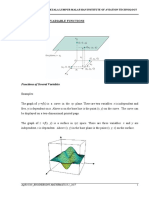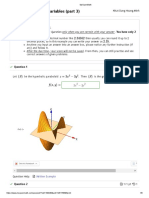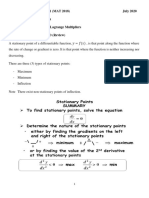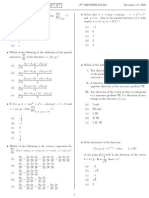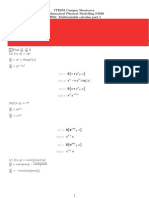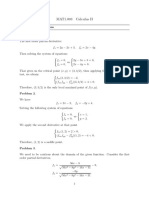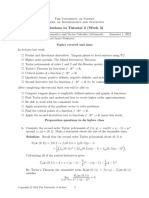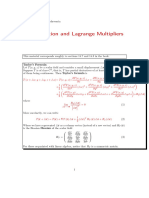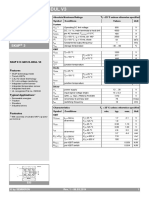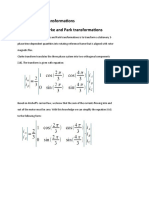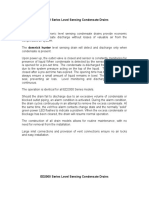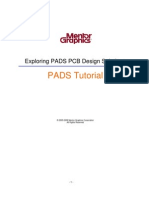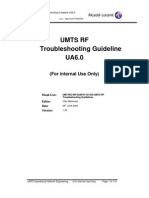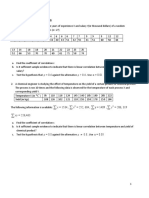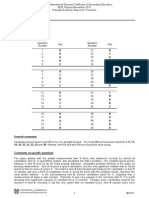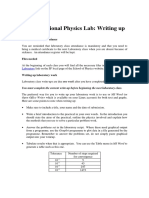12/9/24, 2:33 PM MyOpenMath
Review Assessment Attempts
Tâm, Lê Chí
Quiz 7 - Partial Derivatives (2)
Started: 12/8/24, 12:43 pm
Last Changed: 12/9/24, 2:27 pm
Total time questions were on-screen (all attempts): 356.5 minutes
Due Date: Fri 12/13/24, 11:59 pm
Score in Gradebook: 17/17
Grade is calculated on the best assessment attempt (Attempt 3)
Attempt 3.Score: 17/17. Submitted 12/9/24, 2:27 pm
Show Intro and Between-Question Text
You are in the gradebook. You cannot edit answers or submit questions from here.
Question 1. Score: 1/1
Let w(x, y, z) = −7xy arcsin(z) where x = t
3
, 8
y = t , z = 5t .
dw dx dy dz
Calculate by first finding , & and using the chain rule.
dt dt dt dt
dx
2
dt
= 3t
dy
7
= 8t
dt
dz
= 5
dt
Now use the chain rule to calculate the following (please enter arcsin instead of −1
sin whenever
appropriate):
35t11
dw
= −77t10 · sin−1 ( 5t ) −
dt √ 1 − 25t2
Score: 0.25/0.25 0.25/0.25 0.25/0.25 0.25/0.25
Time spent on this version: 2.2 minutes.
https://www.myopenmath.com/assess2/gbviewassess.php?cid=239601&aid=17844250&uid=0 1/10
�12/9/24, 2:33 PM MyOpenMath
Question 2. Score: 1/1
Given
2 4 2 3 w
z = x + xy , x = uv + w , y = u + ve
∂z
then find: when u = 2, v = −3, w = 0
∂v
−516
Score: 1/1
Time spent on this version: 3.1 minutes. Show all tries
Had help available: Video
Question 3. Score: 1/1
Given f (x, y) = sin(x + y) where x 3 2
= s t , y = 3s − 2t . Find fs(x, y) and . Write answers in
ft(x, y)
terms of the independent variables.
fs(x, y) ( ) (
= 3 cos s3t2 + 3s − 2t · s2t2 + 1 )
ft(x, y) ( ) (
= 2 cos s3t2 + 3s − 2t · s3t − 1 )
Score: 0.5/0.5 0.5/0.5
Time spent on this version: 1.6 minutes.
Had help available: Video
Question 4. Score: 1/1
Calculate Duf (−1, −1, −5) →=
in the direction of v →
−i − 3j − 3k→ → for the function
f (x, y, z) = −2x
2
− 2xy + 2y
2
− 4x + yz + 4z
2
+ 5xz .
Round your answer to four decimal places.
41.7537
Score: 1/1
Time spent on this version: 2.2 minutes.
Question 5. Score: 1/1
https://www.myopenmath.com/assess2/gbviewassess.php?cid=239601&aid=17844250&uid=0 2/10
�12/9/24, 2:33 PM MyOpenMath
x
The temperature at a point on a metal plate is given by T (x, y) =
2 2
. Use this information to
x + y
answer the questions below. Write all vectors in component form and give all answers in exact form.
a. Find the direction of greatest increase of heat at the point (5, 1) .
Direction of greatest increase is ⟨ −6 −5
,
169 338 ⟩
b. Find the rate of maximum temperature increase.
1
Rate of maximum increase is
26
c. Find the direction of greatest decrease of at the point (5, 1) .
Direction of greatest decrease is ⟨ 6
,
5
169 338 ⟩
d. Find the rate of maximum decrease of temperature.
−1
Rate of maximum decrease is 26
Score: 1/1
Time spent on this version: 1.4 minutes.
Question 6. Score: 1/1
https://www.myopenmath.com/assess2/gbviewassess.php?cid=239601&aid=17844250&uid=0 3/10
�12/9/24, 2:33 PM MyOpenMath
Find the directional derivative Du
→f (2, −1) of 2
f (x, y) = x y − 2xy
3 2
− 4y + 3x in the direction of a
π
vector that makes an angle of θ = with the horizontal.
3
(a) Find .
∇f (x, y)
∇f (x, y) = 2xy − 2y + 3
3 →i+ x2 − 6xy2 − 8y →j.
(b) Find ∇f (2, −1) .
∇f (2, −1) = 1i + 0j
→. Enter exact answers, no decimals allowed.
(c) Find the direction vector u
1 √3
→
u = i+ j
2 2
(c) Find the directional derivative
1
Du
→f (2, −1) = 2
Show Detailed Solution
Score: 0.2/0.2 0.2/0.2 0.2/0.2 0.2/0.2 0.2/0.2
Time spent on this version: 2.2 minutes.
Question 7. Score: 1/1
3
3y
Find the maximum rate of change of the function f (x, y) = at the point (3,2)
x
4√ 85
3
Score: 1/1
Time spent on this version: 1.4 minutes.
Had help available: Video
Question 8. Score: 1/1
https://www.myopenmath.com/assess2/gbviewassess.php?cid=239601&aid=17844250&uid=0 4/10
�12/9/24, 2:33 PM MyOpenMath
For the function f (x, y) = −4e5x sin(y), find a unit tangent vector to the level curve at the point
(−3, 3) that has a positive x component. Present your answer with three decimal places of accuracy.
⟨ 0.814,0.580 ⟩
Score: 1/1
Time spent on this version: 11.5 minutes. Show all tries
Had help available: Video
Question 9. Score: 1/1
Given the function f (x, y) = −2 − x2 − y2. Find both unit tangent vector to the level curve at the
point (2, −5). Write the vectors in component and separate each answer with a comma.
⟨ 5
,
2
√ 29 √ 29 ⟩⟨
,
−5
,
−2
√ 29 √ 29 ⟩
Score: 1/1
Time spent on this version: 2 minutes.
Had help available: Video
Question 10. Score: 1/1
Suppose that f (x, y) = x
2
− xy + y
2
− 5x + 5y with x
2 2
+ y ≤ 25 .
−25
1. Absolute minimum of f (x, y) is 3
2. Absolute maximum is 72.85533906 .
Score: 0.5/0.5 0.5/0.5
Time spent on this version: 0.4 minutes.
Question 11. Score: 1/1
https://www.myopenmath.com/assess2/gbviewassess.php?cid=239601&aid=17844250&uid=0 5/10
�12/9/24, 2:33 PM MyOpenMath
Find and classify the critical points of z = (x
2
− 2x)(y
2
− 6y)
Local maximums: ( 1,3 )
Local minimums: DNE
Saddle points: ( 0,0 ) , ( 2,6 ) , ( 2,0 ) , ( 0,6 )
For each classification, enter a list of ordered pairs (x, y) where the max/min/saddle occurs. If there
are no points for a classification, enter DNE.
Score: 0.333/0.333 0.333/0.333 0.333/0.333
Time spent on this version: 1 minutes.
Had help available: Video
Question 12. Score: 1/1
An open-top rectangular box is being constructed to hold a volume of 150 in3. The base of the box is
made from a material costing 5 cents/in2. The front of the box must be decorated, and will cost 9
cents/in2. The remainder of the sides will cost 4 cents/in2.
Find the dimensions that will minimize the cost of constructing this box.
Front width: 5.285904252 in.
Depth: 8.58959441 in.
Height: 3.303690158 in.
Score: 0.333/0.333 0.333/0.333 0.333/0.333
Time spent on this version: 6.8 minutes.
Had help available: Video
Question 13. Score: 1/1
https://www.myopenmath.com/assess2/gbviewassess.php?cid=239601&aid=17844250&uid=0 6/10
�12/9/24, 2:33 PM MyOpenMath
Consider the function f (x, y) = x2y + y3 − 12y. For each point below, choose whether it is a
maximum, a minimum, a saddle point, some other type of critical point, or not a critical point.
(0, −2)
a saddle point
a maximum
some other critical point
no critical point
a minimum
(−2√ 3, 0)
a maximum
a saddle point
no critical point
a minimum
some other critical point
(2√ 3, 0)
a maximum
no critical point
a minimum
some other critical point
a saddle point
(0, 2)
a minimum
a maximum
some other critical point
https://www.myopenmath.com/assess2/gbviewassess.php?cid=239601&aid=17844250&uid=0 7/10
�12/9/24, 2:33 PM MyOpenMath
no critical point
a saddle point
(0, 0)
a saddle point
some other critical point
a maximum
no critical point
a minimum
Score: 1/1
Time spent on this version: 0.3 minutes.
Question 14. Score: 1/1
Find the maximum volume of a rectangular box whose surface area is 1600 cm2 and whose total edge
length is 200 cm.
112000
cm3
27
Score: 1/1
Time spent on this version: 8.1 minutes.
Question 15. Score: 1/1
Find the minimum cost of a rectangular box of volume 200 cm3 whose top and bottom cost 2 cents per
cm2 and whose sides cost 4 cents per cm2.
Cost = 652 cents.
Score: 1/1
Time spent on this version: 4.4 minutes. Show all tries
Question 16. Score: 1/1
https://www.myopenmath.com/assess2/gbviewassess.php?cid=239601&aid=17844250&uid=0 8/10
�12/9/24, 2:33 PM
The paraboloid z = x
New objective:
away from the origin.
The point:
The distance:
The point:
The distance:
(
2 2
+ y
g(x, y) =
√ 9 + 5√ 3
⎪
intersects the plane
⎧ max./min.
⎨ s.t.
⎩
2 2
x +y + x +y
New constraint: x + y + x2 + y2 = 1
−1 − √ 3 −1 − √ 3
2
, 2
,2 + √ 3
( 2
We have now constructed an equivalent optimization problem.
MyOpenMath
x + y + z = 1 in the shape of an ellipse.
The objective of this problem is to find the point on the ellipse closest and furtherest away from the
origin. To this end, we establish the following constrained optimization problem:
2 2
f (x, y, z) = √ x + y + z
z = x
2
+ y
x + y + z = 1
2
2
To reduce the problem from three variables to two (i.e., removing z), substitute the first constraint into
the objective function and square the result, then substitute the first constraint into the second
constraint.
2 2)
Use the equivalent optimization problem above to find the point on the ellipse that is the furtherest
)
Finally, find the point on the ellipse that is the closest from the origin.
( −1 + √ 3 −1 + √ 3
2
,
√ 9 − 5√ 3
2
,2 − √ 3 )
Score: 0.167/0.167 0.167/0.167 0.167/0.167 0.167/0.167 0.167/0.167 0.167/0.167
Time spent on this version: 2.9 minutes.
Question 17. Score: 1/1
https://www.myopenmath.com/assess2/gbviewassess.php?cid=239601&aid=17844250&uid=0
Part 1 of 2
Part 2 of 2
9/10
�12/9/24, 2:33 PM MyOpenMath
Find the maximum value of the function f (x, y, z) = xyz subject to the constraint
2 2 2
9x + 4y + 6z = 1.
Enter an exact answer.
√2
108
Score: 1/1
Time spent on this version: 5.6 minutes.
Return to Gradebook
https://www.myopenmath.com/assess2/gbviewassess.php?cid=239601&aid=17844250&uid=0 10/10














